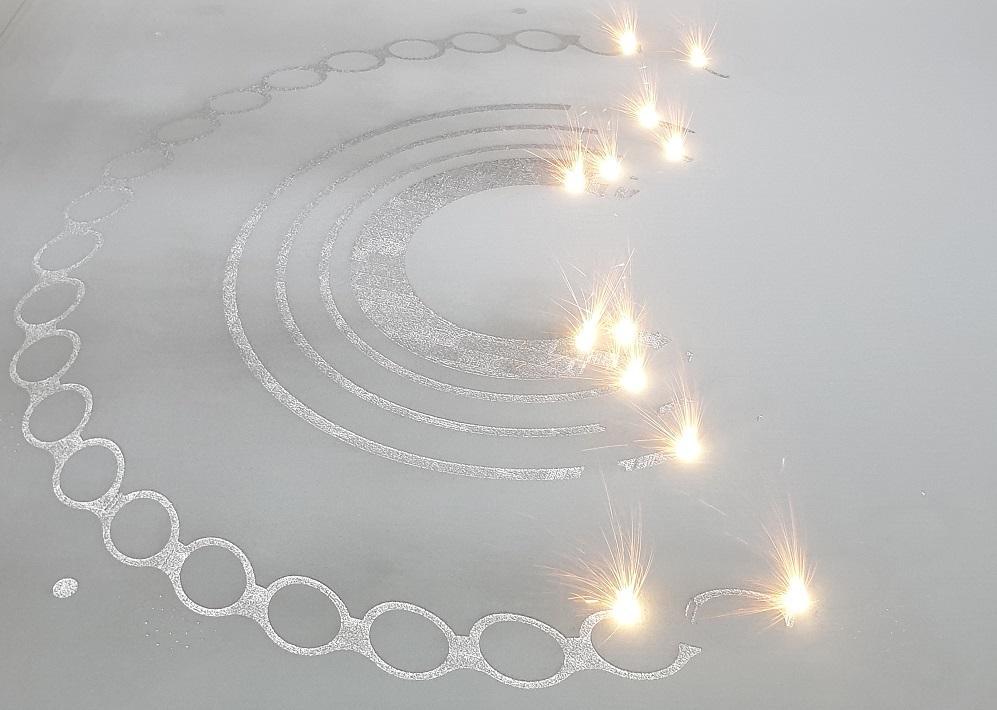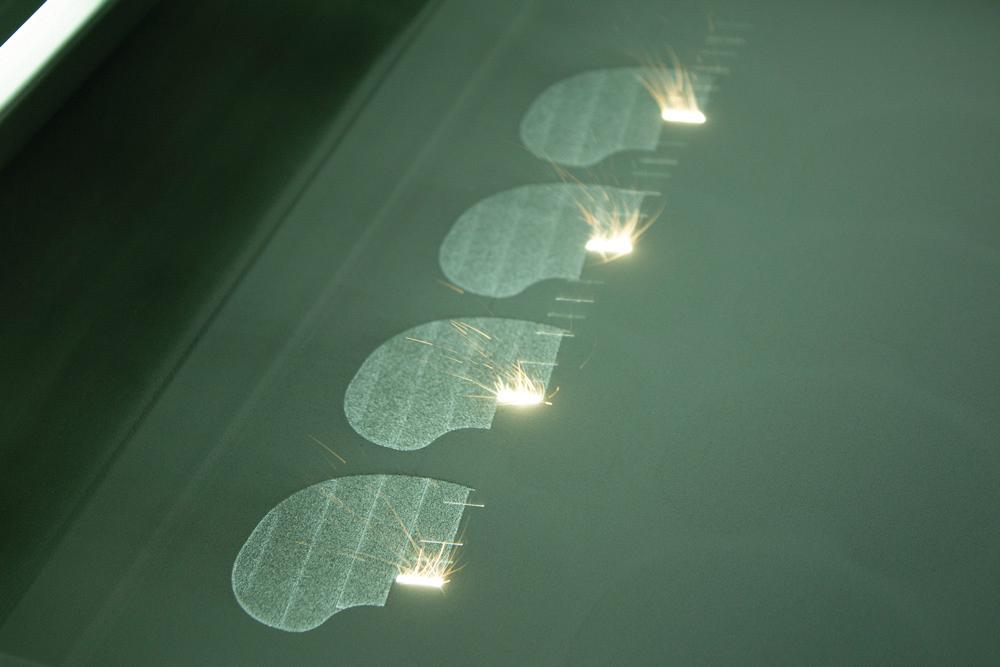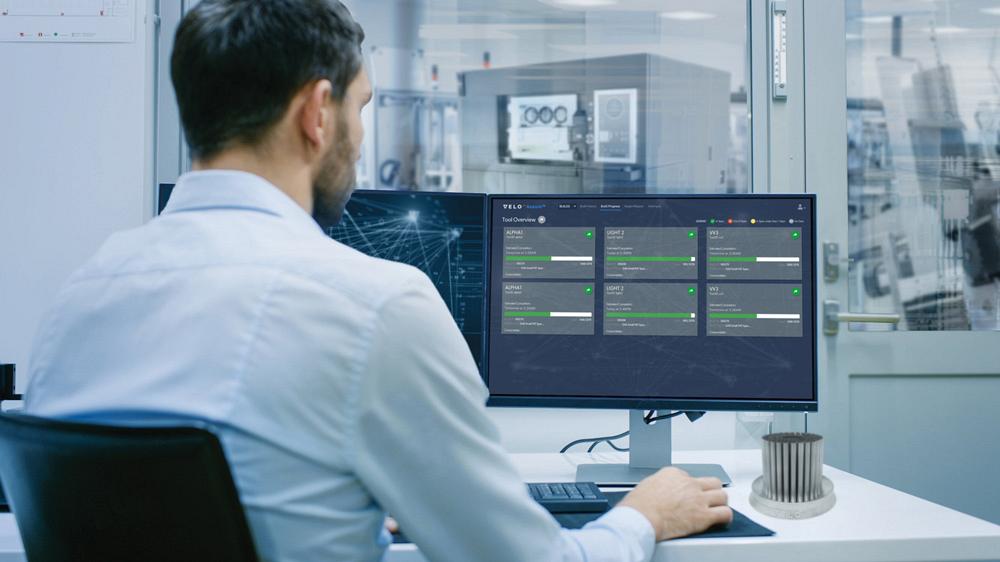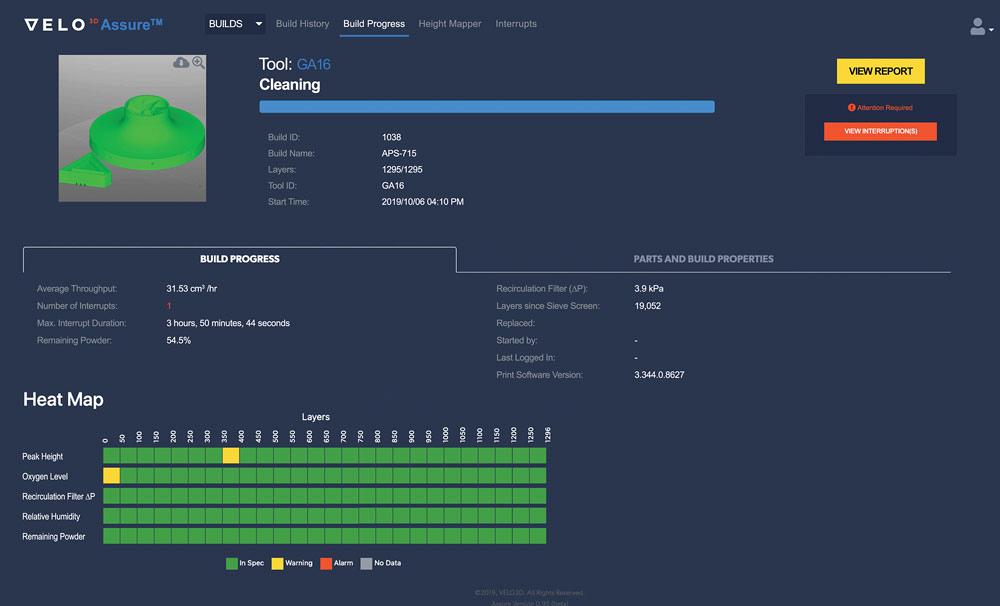Associate Editor
- FMA
- The Fabricator
- FABTECH
- Canadian Metalworking
Get more with multi-laser additive manufacturing
Multilaser AM machines increase throughput, decrease cost per part
- By Lindsay Luminoso
- May 31, 2021
- Article
- Metalworking

More lasers in the work envelope can allow for a larger print area, which means you can print larger parts quickly. SLM Solutions Group
As additive manufacturing (AM) becomes more of a production tool, many machine shops may look to this technology as a way forward. The latest trend in AM is multilaser machines. But how do these machines stack up against their single-laser counterparts?
Know When It Makes Sense
For shops looking to take the plunge into AM, it’s important to explore why and how it will be used. From a production standpoint, shops need to examine the parts it wants to produce using this technology and whether the number of parts and part geometry are suitable for a multilaser machine.
“The big driver for multilaser technology is really the substantial throughput increase and the cost-per-part reduction over the single-laser platform of a similar size,” said Carl Hamann, solutions centre manager, Renishaw, Mississauga, Ont. “It truly becomes a production solution for components that you may not have actually been able to print cost-effectively on a single-laser machine.”
For shops just looking to make prototypes or support R&D efforts, a single-laser machine is a great option. But for those looking for significant throughput gains, multilaser technology really shines.
“More can be better if done correctly,” said Dr. Zach Murphree, vice-president technical partnerships, VELO3D, Campbell, Calif. “More lasers can allow for a larger print area, which means you can print larger parts. It also can significantly improve the throughput of a machine, and this translates to lower part cost at the end of the day. As long as the potential issues of multilaser printing are properly accounted for, more should be better.”
For those that are trying to decide between a single-laser or multilaser system, it’s all about answering certain production questions. How many parts are in the production run? How many components can fit in the build envelope at one time? Can a larger component fit in the build envelope? It’s not necessarily just about what a shop is currently producing, but also what future opportunities open up with the expanded capabilities of a multilaser system.
Even with productivity increases, quality can’t be ignored. To be effective, multilaser AM systems must produce the same material properties as single-laser systems.
“In the most important category of quality, multilaser systems achieve the same homogenous material properties in areas of the part using multiple lasers versus areas of the workpiece using just one laser,” said Graham F. Boyd, sales manager, SLM Solutions NA, Wixom, Mich.
“There's been some questions surrounding the metallurgy of components,” said Hamann. “You have the components coming off of multilaser machines with just as good part density as parts completed with a single laser. There’s definitely a lot of stigma, and people worry that parts are going to be worse off produced with multiple lasers. But that's not the case.”
Boyd echoed this by adding that it really is a common misconception that part properties are not consistent throughout the workpiece using multilaser systems, countering that these systems offer the same quality levels as single-laser counterparts so long as all processing challenges are handled appropriately.

Using multiple lasers to build one part is a good way to increase productivity. However, Hamann believes that users will get peak efficiency when each of the lasers are used equally to produce multiple parts. Renishaw
From a business vantage point, over 50 per cent of the SLM Solutions systems installed worldwide are multilaser systems, with that number growing year over year.
“Customers can expect productivity gains of 2 to 20 times in build rates. Where a single-laser system may have build rates of 25 cm³ per hour, on a quad-laser system, that number jumps to 175 cm³ per hour. This is an important step change in addressing printing costs in the AM value stream,” said Boyd.
The latest multilaser AM systems give shops the ability to lower the overall cost of an AM-built component for serial production.
“The build rates and productivity [these types of machines] achieve allow manufacturers a direct, tangible comparison to conventional manufacturing methods,” said Boyd.
Choose a Build Strategy
Once a shop has decided on a multilaser system, the next step is to choose a build strategy.
“It’s all about turnaround time on the machine, so you definitely want to try to maximize laser utilization,” said Hamann. “You definitely want to take into consideration how long a build might be, and sometimes you may want to split the builds into two, maybe two builds versus one, just depending on what you're building. So there's some application considerations depending on the components, but in most cases, you want to try to build as many parts as you can at one time to maximize the machine’s utilization.”
The strategy will typically depend on the number of lasers in the system, but there are two main strategies that many shops work within: (1) use the system’s multiple lasers collectively on a single part or (2) use each of the system’s lasers on individual parts.
The chosen strategy depends on part geometry and on the number of components that you can fit within the build envelope. In most multilaser systems, the lasers can overlap and work within the entire build area. For example, if the machine has four lasers working on one part, it can print four times faster than a single-laser machine.
According to Hamann, using multiple lasers to build one part is a good way to increase productivity. However, he believes that users will get peak efficiency when each laser is used equally to produce multiple parts.
“You always want to have the multiple lasers building at the same time to maximize your productivity on the machine,” he said.

As AM moves from a niche manufacturing process with bespoke software products to a much more widely adopted process, the software ecosystem around AM is going to evolve quite a bit. VELO3D
There are some regulatory concerns to consider when deciding on a build strategy. Some industries require that only one laser be used to build a part, so these regulatory limitations need to be taken into account.
Choosing the strategy of using each of the system’s lasers on multiple individual parts in the build envelope especially makes sense if the part run is a multiple of the number of lasers. For example, if there are four lasers and 16 parts, then it’s easy to choose this type of strategy because it’s the most productive way to produce small parts.
“If your parts get bigger, let's say you can fit only two parts on the plate -- then it makes sense to use multiple lasers per part,” said Hamann. “But when you're in the realm of enough parts that each laser builds its own part, that is really the most effective way to utilize the machine.”
Take Advantage of Software
The latest software tools and features can make all the difference when it comes to producing quality parts. For the most part, all laser assignment is done through software, and there are a number of tools that can help shops optimize the process. They also can choose to manually assign the lasers to individual or multiple parts.
“I think the software ecosystem around AM is going to evolve quite a bit in the coming years,” said Murphree. “AM is going from a niche manufacturing process with bespoke software products to a much more widely adopted process, and this will cause consolidation and integration on the software side as more standard software tools incorporate AM. I don’t mean this just in terms of print preparation software, but more in terms of the entire manufacturing process.”
Understand Laser Alignment Challenges
Whichever build strategy is used, it’s important to maximize alignment and balance on the lasers.
“Laser calibration is always important,” said Boyd. “However, it’s even more critical with multilaser systems given two lasers are potentially working on the same area of the part, stitching the metal to achieve homogenous part properties.”
According to Murphree, laser alignment is one of the most challenging issues with multilaser AM.
“If the lasers aren’t properly aligned to each other, there will be witness lines in the parts and you will be able to see the transition from one laser to another on the surface of the part,” he said. “This can also imply that there may be issues underneath the surface, for example, porosity, and this can negatively impact mechanical properties. The alignment generally shifts over time, so the initial calibration is not sufficient to make sure this issue is addressed; you also need to check this on a regular basis. There is also the issue of avoiding shooting the smoke. When a laser is melting material, it will generate a soot plume, and if another laser is working downstream in this plume, it will likely make subpar material (the porosity issue again) because the laser energy will be partially blocked by the soot.”
Dealing with the soot problem can be as easy as properly managing gas flow.

So long as the potential issues of multilaser printing are properly accounted for, more should be better and can help shops increase throughput as well as decrease cost per part. VELO3D
Maintain Appropriate Gas Flow
Gas flow is very important within a machine. With multiple lasers melting instead of one, shops must ensure that the machine and build area are clean. This is especially critical to maintain the necessary metallurgic properties.
“Obviously, with introducing more lasers, the process inherently will create more soot and condensate in the chamber environment,” said Boyd. “As such, the evacuation and removal of this condensate becomes paramount by having a robust gas flow system that ensures no unwanted debris created from the process lands on the part, potentially creating a part defect.”
Deal With Thermal Stability
When a shop is working with multiple lasers, thermal stability can be a challenge too.
“You certainly want all lasers to see the same thermal load,” said Hamann. “This is very important when you're working with multiple lasers per part because if lasers are heating up differently or they are not stable, then they're not going to be able to build that part as accurately or as cleanly as they would with a stable optical system.”
Upgrade Powder Management Strategy
Powder management is another thing to consider. The more lasers there are building in the machine, the faster the machine operates, and the more shops need to think about adopting a powder handling system on the machine.
“An automated powder handling system can recycle the powder within the machine,” said Hamann. “Something like this will eliminate the need for the user to intervene and maintain the powder level in the system. That is a big advantage for a multilaser system because there are cases where a user would have a hard time keeping up with the machine usage of powder during the build.”
Boyd also noted that when it comes to powder in general, there is less aggregate material allowables data available because they just haven’t had the time and resources applied to them in comparison to single-laser systems. This applies to each machine configuration, material, and layer height permeation out there.
Take Advantage of the Latest Technology
As more multilaser systems enter the market, the need for further innovation will follow. According to Hamann, these systems will get bigger and bigger with larger build envelopes and more lasers. Although there are some additional challenges with including more lasers and expanding the machine envelope, the productivity gains are significant, and challenges can be overcome.
The experts agree that the industrial internet of things and connected technology is on the horizon. As these machines become more sophisticated, the need for sensor technology seems like an easy leap. This idea of closed-loop manufacturing is expected to take hold in multilaser manufacturing environments.
“I think the use of simulation will also be the next wave of innovation,” said Hamann. “This will give users the ability to see what will happen more accurately and provide more information about [what will happen] in the machine. Users also want more automation, so we are seeing more Industry 4.0 technology integrated from end to end.”
“Other trends we’re seeing are low-angle, support-free printing; quality assurance innovations; and a breadth of new applications moving to serial production,” said Boyd.
Ask Questions
For shops that are just not sure how a multilaser system can work for them, asking questions can be a great way to glean insights about potential applications and productivity gains. Asking questions about common concerns can also dispel some of the myths about moving to this newer technology.
“Multiple lasers can add quite a bit of complexity,” said Murphree. “How does it manage that amount of thermal energy being applied to the bed? How is the gas flow kept consistent over a larger build area? How do you properly schedule and apportion the printing between the various lasers?”
Asking the experts can help to assuage any concerns that shops may have when deciding to adopt this technology. AM machine builders can also help alleviate any process concerns shops may have along the way by offering best practices and giving application-specific advice.
Associate Editor Lindsay Luminoso can be reached at lluminoso@canadianmetalworking.com.
Renishaw, www.renishaw.com
SLM Solutions Group, www.slm-solutions.com
VELO3D, www.velo3d.com
About the Author

Lindsay Luminoso
1154 Warden Avenue
Toronto, M1R 0A1 Canada
Lindsay Luminoso, associate editor, contributes to both Canadian Metalworking and Canadian Fabricating & Welding. She worked as an associate editor/web editor, at Canadian Metalworking from 2014-2016 and was most recently an associate editor at Design Engineering.
Luminoso has a bachelor of arts from Carleton University, a bachelor of education from Ottawa University, and a graduate certificate in book, magazine, and digital publishing from Centennial College.
Related Companies
subscribe now


Keep up to date with the latest news, events, and technology for all things metal from our pair of monthly magazines written specifically for Canadian manufacturers!
Start Your Free Subscription- Trending Articles
Sustainability Analyzer Tool helps users measure and reduce carbon footprint

Enhance surface finish with high-speed machining

Equispheres secures $20 million investment round

Solid carbide drills produce precision holes in short chipping materials

Okuma announces new personnel appointments

- Industry Events
Automate 2024
- May 6 - 9, 2024
- Chicago, IL
ANCA Open House
- May 7 - 8, 2024
- Wixom, MI
17th annual Joint Open House
- May 8 - 9, 2024
- Oakville and Mississauga, ON Canada
MME Saskatoon
- May 28, 2024
- Saskatoon, SK Canada
CME's Health & Safety Symposium for Manufacturers
- May 29, 2024
- Mississauga, ON Canada















